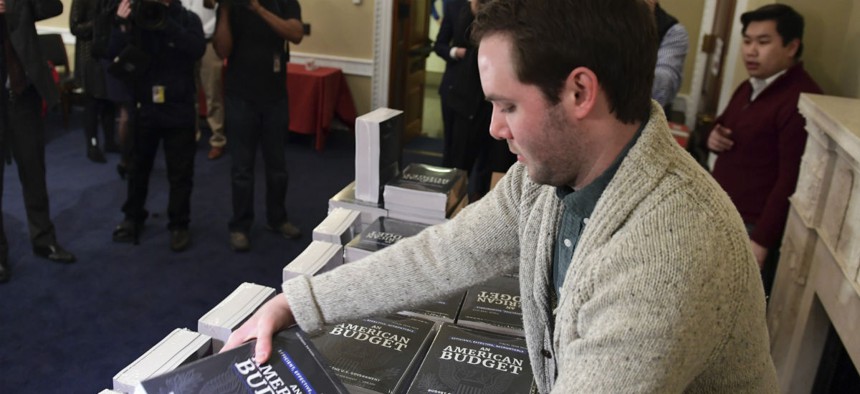Transferring Responsibilities and Consolidating Offices Highlight Trump Reorganization Plan
Long-awaited agency reform plans offer light details, promises of future reforms proposals.
More than one year after President Trump issued an executive order calling on all federal agencies to submit a comprehensive plan to reorganize and reform themselves, the administration has proposed what it is now calling a “first step” toward submitting those changes.
The proposals were laid out in Trump’s fiscal 2019 budget, often focusing on consolidating administrative functions or merging various programs with similar functions, but not every agency detailed its plans. Some agencies put forward more specific ideas, such as shifting bureaus to new locations or transferring responsibilities to other agencies. The administration said more details would be forthcoming, pledging to create concrete goals and trackable metrics with “senior accountable officials” to oversee them.
The Trump administration will list some of those metrics and its progress in meeting them on Performance.gov, which will spell out both individual agency and cross-agency priority goals. Agencies have not updated the site since Trump took office, but on Tuesday summarized what the new goals will look like.
From a broad perspective, the administration will focus on moving federal agencies and their employees toward more high-impact work, as it seeks to eliminate reporting requirements and “keep pace with an environment of change.” Some of the proposals, the White House said, stemmed from reforms identified by individual federal employees who “answered the administration’s request for their best ideas to improve public services or better use taxpayer dollars.” The White House will release its full president’s management agenda in March, according to budget documents.
The Interior Department laid out one of the most specific reorganization plans, which would cost $18 million to initiate. The proposal would move the department toward a more “integrated” system organized around watersheds rather than states. The plan would “break silos among bureaus” by co-locating offices and focusing on improving coordinated decision making. Interior called the reforms a “one-agency model” that would move resources closer to the lands it manages.
The Agriculture Department detailed its previously announced shuffling around of offices and announced a proposal to create a “business innovation center” in each mission area. Those centers would support collaboration between agencies, the White House said. USDA would absorb control of the planned National Bio and Agro-Defense Facility from the Homeland Security Department, while losing its role in the Jobs Corps program.
Several agencies announced plans to conduct future reviews. The Energy Department will review its existing national laboratory network to “identify potential efficiencies.” The Health and Human Services Department will release “in the months ahead” a review of the U.S. Public Health Service Commissioned Corps, which will focus on “reinventing the Corps into a smaller, more targeted cadre focused on providing the most vital public health services and emergency response.” The departments of Labor and Education are working on a plan to consolidate and reorganize workforce development programs, which they will release in the spring as part of a larger reorganization package.
Other proposed transfers included the Transportation Department moving its job training programs to Labor and the Bureau of Alcohol, Tobacco, Firearms and Explosives unloading all of its alcohol and tobacco responsibilities to the Treasury Department. Elsewhere in the Justice Department, the Bureau of Prisons would “realign regional offices” to eliminate duplication. Other proposed internal consolidations included the State Department merging some grant programs, the Veterans Affairs Department folding its various initiatives enabling veterans to seek private care into one program, the National Institutes of Health streamlining three research programs into one and DHS unifying various counter-thread missions into the Countering Weapons of Mass Destruction Office.
State, Transportation and Labor were among the agencies promising to consolidate their administrative functions through maximizing shared services and other proposals. After Secretary Rex Tillerson promised significant cuts and sweeping changes at State through his redesign effort, the proposals in the budget were comparatively minor in scope and included shedding just 200 workers.
All told, the budget projected a $3.6 billion reduction to deficits over the next decade. In fiscal 2019 alone, the blueprint calls for $48 billion in cuts to discretionary spending. Going forward, the administration pledged to focus not on “isolated efforts” but instead “at the junctions where key drivers of change intersect.” In order to reach its goals, the administration acknowledged it will need help from Congress.
“In some cases, real change may demand different agency structures,” the White House said. “In other cases, the administration may require flexibility from existing requirements that impede constructive change.”
The administration was optimistic it could effect the change it has, or will, call for: “By acknowledging shortcomings, setting a modern vision, and delivering on concrete goals, the administration can adapt federal programs, capabilities, and the federal workforce to meet mission demands and public expectations more efficiently, effectively and accountably.”




